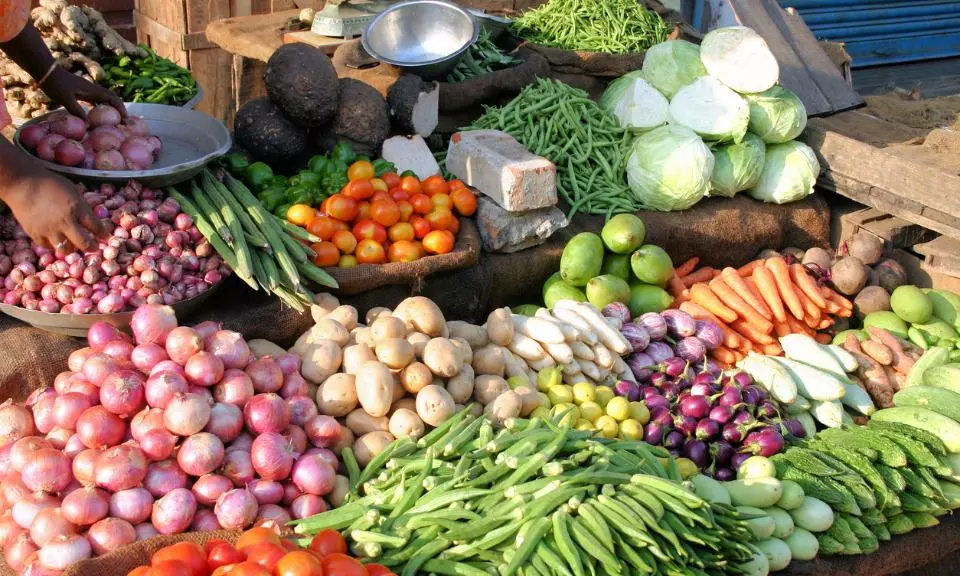
Base effect apart, easing food prices promise another 6 months of low inflation
Consumer Price Index stands at 2.10 pc year-on-year in June, marking lowest inflation reading since January 2019, offering some much-needed relief to households

India’s consumer inflation cooled sharply in June, falling to its lowest level in over six years. The headline Consumer Price Index (CPI) stood at 2.10 per cent year-on-year, down from 2.82 per cent in May. This marks the lowest inflation reading since January 2019, offering some much-needed relief to households.
Also read | WPI inflation falls to minus 0.13 pc in June as prices ease
The steep decline was led by a broad-based fall in food prices. The Consumer Food Price Index contracted by 1.06 per cent in June compared to the same period last year, marking a sharp drop of 205 basis points from May. Food inflation fell by 1.22 per cent in urban areas and by 0.92 per cent in rural areas, suggesting the easing in prices was widespread and not limited to a few regions.
Decline in food prices
This decline covered a wide range of staples. Prices of vegetables, pulses, cereals, meat and fish, sugar, milk and dairy products, and spices all saw notable corrections. Thanks to this across-the-board softening, rural inflation fell to 1.72 per cent in June, down from 2.59 per cent the previous month. Urban inflation also slowed to 2.56 per cent from 3.12 per cent in May.
A favourable base effect played a key role in pushing down the headline number. Inflation had been elevated around this time last year, which means that even modest price increases this year now appear significantly lower by comparison. But analysts say this is not just a statistical illusion. A strong Rabi harvest, solid stocks of wheat and rice, and improved vegetable and pulse supply chains are also contributing to the sustained softness in food prices.
“We expect inflation to come down further because of these base effects and the way food prices are moving this season. A good Rabi harvest and solid stocks of wheat and rice are helping too,” said Kanika Pasricha, Chief Economic Advisor at Union Bank of India.
Nationwide trend
HSBC economists shared a similar outlook, noting that with decent weather and strong cereal production, inflation is expected to average around 2.5 per cent over the next six months. They added that the high inflation base from the last three years would also help keep headline numbers in check.
Also read | Retail inflation dips to 6-year low of 2.82 pc in May
Beyond food, other essential categories have seen only mild price increases. Housing inflation inched up to 3.24 per cent in June from 3.16 per cent in May. Education inflation rose to 4.37 per cent from 4.12 per cent, while healthcare costs increased slightly to 4.43 per cent from 4.34 per cent. Transport and communication costs rose marginally as well, climbing to 3.90 per cent from 3.85 per cent. However, fuel and light inflation eased to 2.55 per cent, down from 2.84 per cent the previous month.
Inflation cooled across all major states, though the pace varied depending on local crop performance, rainfall, and supply logistics. Still, government data shows that both headline and food inflation fell in every region, pointing to a nationwide trend.
Core inflation stable
Economists are also watching core inflation, which excludes food and fuel. While stable overall, some components have shown mild upward pressure in recent months.
“The June CPI inflation print of 2.1 per cent was lower than expected, mainly due to softer food prices. Core inflation is rising slightly, driven by gold prices, but remains comfortable without that impact,” said Suvodeep Rakshit, chief economist at Kotak Institutional Equities.
India’s wholesale inflation (WPI) turned negative in June 2025, registering a year-on-year decline of 0.13 per cent, the first drop since October 2023. This deflation was mainly driven by falling prices of food articles, mineral oils, and basic metals, reflecting broad-based easing across key commodity groups.
Room for monetary easing
Rakshit noted that the wholesale inflation reading for June has further strengthened the case for monetary easing. “The June CPI reading, along with deflation in the wholesale price index, provides ample room for the RBI to reduce the repo rate. We expect the average CPI inflation for FY2026 to come in well below the RBI’s current forecast of 3.7 per cent. While the central bank may stay on hold in August as it waits to see how the monsoon plays out, the June data has raised the odds of a 25 basis point rate cut in October,” he told The Federal.
Also read | India set to remain fastest growing major economy in FY26: RBI
The Reserve Bank of India (RBI), which had already cut its benchmark repo rate by 50 basis points in May, is now seen to have more flexibility in its monetary stance. Although it continues to signal a neutral position, the path is increasingly open to additional cuts if inflation remains this low. The RBI’s forecast for the full financial year currently stands at an average inflation of 3.7 per cent, but with the April to June quarter already coming in at 2.9 per cent, that number may soon be revised downward.
For now, the outlook remains positive. A good monsoon, stable food supplies, and a high statistical base from previous years all suggest that inflation could stay comfortably low in the near term. But risks remain. A poor or uneven monsoon could quickly reverse the decline in food prices, said experts, adding global spikes in oil or fertiliser prices could also pass through to domestic inflation. While food prices are currently easing, expenses in categories such as health and education continue to rise steadily.

